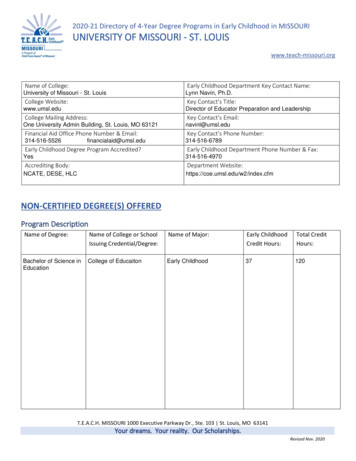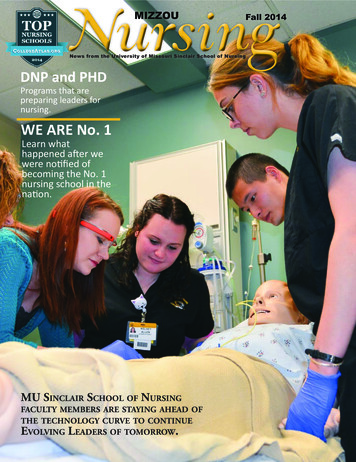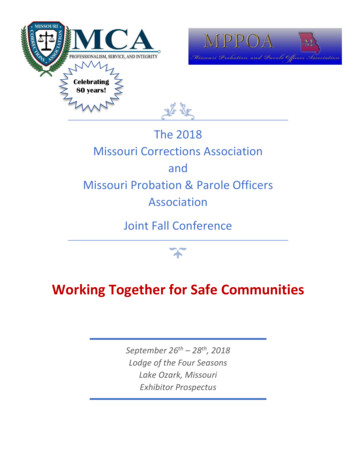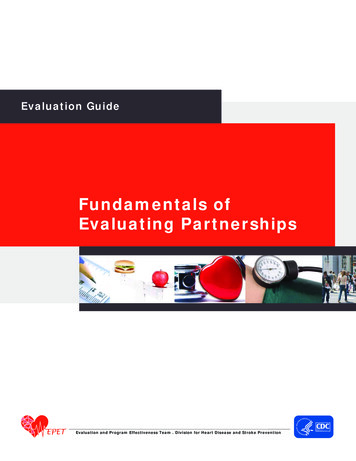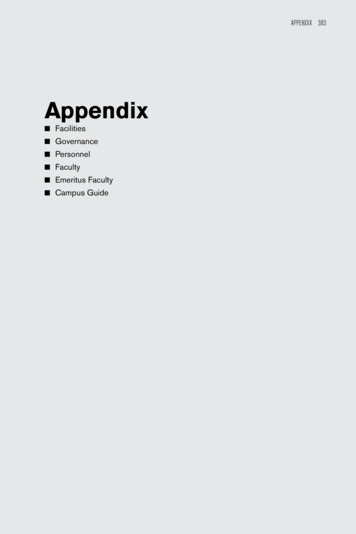
Transcription
APPENDIX 383Appendix Facilities Governance Personnel Faculty Emeritus Faculty Campus Guide
384 APPENDIX: FacilitiesFacilitiesAdministration BuildingBuilt in 1907-1910, this Tudor Revival structure with its four towers is the landmark of thecampus. In 1979, a fire destroyed the north wing and the west wing, the latter of which is largelyrestored. In addition, the entire second floor and a portion of the third floor have been extensively renovated. This historic building houses Admissions, Career Services, Graduate Office,Registrar’s Office, Scholarships and Financial Assistance Office, Cashiering, Bursar’s Office,and other administrative and student services offices. It was added to the National Registry ofHistoric Places in 2010.Alumni HouseLocated on College Avenue, this structure is owned by the non-profit Northwest Foundationand houses the Office of University Advancement and Alumni Relations. This former privateresidence is the social center for alumni and friends of Northwest.Everett W. Brown Education HallLocated across from the J.W. Jones Union, this Neo-Gothic ornamented structure was renovatedand rededicated in 1987 to Everett W. Brown, an alumnus, long-time staff member, eight-termmember of the Missouri House of Representatives and former appointed member of the MissouriCoordinating Board for Higher Education. Originally dedicated in 1939, Brown Hall housesthe Department of Professional Education, as well as the Horace Mann School for elementaryeducation.Center for Innovation and Entrepreneurship (CIE)Construction of the Center for Innovation and Entrepreneurship was completed in 2009. Thestructure includes two connected facilities: a business incubator on the west and a combinedacademic/teaching/research space on the east. The Incubator houses commercial researchlaboratories, offices and small scale production space for several businesses. The Small Business& Technology Development Center is also housed in the building. The academic space housesclassrooms, faculty offices, and applied research labs.Colden HallCompleted in 1959, this V-shaped structure is named for Charles J. Colden, the first presidentof the Board of Regents. This major academic structure was completely renovated in 1996-1997providing environments for technology to supplement and facilitate learning, and with flexibility for advancements in the future. Located on the second floor are the faculty and staff officesfor Business; Computer Science and Information Systems; English; and Behavioral Sciences.
APPENDIX: FACILITIES 385Mabel Cook Recruitment and Visitors CenterLocated at the southeast entrance to campus, the center is named for a graduate of theDepartment of Family and Consumer Sciences, who later served on the faculty and chairedthe department. As a student, Mabel Cook initiated the idea for Kappa Omicron Phi, now anational family and consumer sciences honor society called Kappa Omicron Nu. The houseis now used as a visitors center for prospective students and their families as well as housingAdmissions personnel and Student Ambassadors.Raymond J. Courter College Park PavilionThe Pavilion in College Park located west of the Ron Houston Center for the PerformingArts was completed in 2005. It includes a 5,600 square foot outdoor ampitheatre with stage,theatrical lighting, storage and restrooms for University and community events. The Pavilionis named in honor of Raymond Courter whose influence over 37 years of service and as chieffinancial officer guided master planning for capital construction projects resulting in additionsor improvements to nearly 30 campus buildings and structures.DeLuce Fine Arts BuildingLocated on the south side of the campus, this circular structure was dedicated in 1965 and honorsthe long-time faculty member and nationally-recognized leader in art education, Olive DeLuce.DeLuce contains studios, the DeLuce Gallery, classrooms, rehearsal rooms, and faculty and staffoffices for Art and Music.The 549-seat Charles Johnson Theater, housed in DeLuce, is named for the first chairman of theSpring Festival of the Arts, which evolved into the year-long Northwest Encore Performances.The Charles Johnson Theater also has a two-manual, 21-rank McManis pipe organ.Fire Arts BuildingThis triangle shaped building constructed in 2004-2005 is located to the southeast of the DeLuceBuilding. It houses ceramics, sculpting and welding art classes.Garrett-Strong Science BuildingThis building on the north side of campus honors two former department chairmen: William T.Garrett, Department of Biological Sciences; and J. Gordon Strong, Department of Chemistryand Physics. Completed in 1968, Garrett-Strong contains laboratories, lecture halls and classrooms, as well as faculty and staff offices for Biology; Chemistry; Physics; Geology; Geography;and Mathematics. The entire building was renovated in 2000-2001 resulting in a state-of-the-artfacility. The botany laboratory and greenhouse building were added in 2002.Thomas J. Gaunt HouseLocated across from the Alumni House on the south end of campus, the Gaunt House wasconstructed in 1870 by a retired sea captain whose tree nursery was located on what is now themain campus. The Classical Revival-style structure has been the home of University presidentssince the founding of the institution in 1905, and it is listed in the National Register of HistoricPlaces. In 1999-2000, a new addition was added that expanded the kitchen to include daily familyuse and a food preparation area for large group gatherings. A new outside patio was also added.Extensive renovations to the entire house were completed in 2009-2010.
386 APPENDIX: FacilitiesRon Houston Center for the Performing ArtsBuilt in 1984, the Ron Houston Center for the Performing Arts is named for Ron Houston,whose generosity led to a significant expansion of performance facilities available to Northwesttheatre students. The center also includes the Mary Linn Auditorium, named after Mary CasteelLinn, a former University Regent and dedicated patron of the arts. The 1,099-seat theater canaccommodate a full symphony orchestra, or it can be scaled down for more intimate productions.The Houston Center also houses a “black box” theater as well as the offices and productionshops of University Theatre. A Studio Theatre addition connected to the Houston Centerfor the Performing Arts on the southeast side opened in 2008. The Studio Theatre functions asa drama laboratory and contains state-of-the-art technology, including an articulated lightinggrid, a makeup lab/classroom and a new lighting and sound control system. The Studio Theatreseats up to 250 people, depending on how the space is configured, and provides a more intimateenvironment for student and departmental performances.J.W. Jones UnionThe opening of this structure in the center of campus in 1952 fulfilled a long-time dream of J.W.Jones, sixth president of the University. In 1966, an addition on the north more than doubledthe size of the building. During 1998-2000 the entire facility underwent a complete renovationand reconfiguration of spaces.Alfred McKemy Center for Lifelong LearningLocated north of the Garrett-Strong Science Building, this structure was completed in 1977 andis named after a former member and president of the Board of Regents. Completely renovatedin 1999, it houses the Math Skills Laboratory which is used to assist students in improving theirmathematics literacy.Contained within are one distance learning classroom and one room forteleconferencing.Memorial Bell TowerCompleted in 1971 and refurbished in 1989, and completely renovated in 2004, this 100-foothigh structure located in the center of campus dominates the campus vista. The Bell Tower wasconstructed from funds provided by University friends and alumni and has brass memorial andcommemorative plaques, an electric carillon and displays the University seal as it has evolvedwith name changes from Normal School to University.Ryland Milner ComplexNamed for long-time coach, athletic director and alumnus Ryland Milner, the Complex contains two gymnasiums, an aquatic center, tennis courts and Bearcat Stadium, all located on thesouthwest side of campus.Uel W. Lamkin Activity Center, named for the University's fifth president, was first openedin 1959. During the 1993-1994 academic year, the facility was the recipient of a 6 millionrenovation and enlargement. Included was the total renovation of the existing structure and theconstruction of north and south additions. The north expansion, called the Northwest StudentRecreation Center, houses a suspended jogging track, three basketball courts and five racquetball/handball courts. Included in the south addition is the Fitness Center on the lower level, a lobbyon the main level, and offices and meeting rooms for coaches on the top level. The area where
APPENDIX: FACILITIES 387basketball and volleyball competition is held has been named the Bearcat Arena. The Arenawood floor was replaced in 2011. Also housed in the Activity Center are classrooms and ticketand concession areas on the main level. The lower level has weight-lifting, dressing rooms andathletic training facilities.Martindale Hall, opened in 1926, was the original University gymnasium. Remodeled andrenovated in 1973-1975, Martindale honors Nell Martindale Kuchs, a faculty member andearly leader in women’s athletics. Martindale has a regulation-sized basketball court, replacedin 2011, which can be split for two separate activities such as gymnastics, dance and volleyball.The building also contains classrooms, physical education faculty offices, a dance studio andwomen’s dressing rooms.Bearcat Stadium is a playing field with permanent seating accommodating 6,200 spectatorsand stadium capacity of 7,500. The field is surrounded by the Herschel Neil Track, a resilientall-weather track named after the 1930s Northwest student who held numerous NCAA records.During calendar year 2000, the east grandstand and southeast ticket houses were completelyrenovated to enhance customer services. In 2002-2003, the west grandstand and pressbox werereplaced by an enlarged facility featuring chairback, railback and traditional seats, 10 suites, andan upper media/coaching area and filming tower. A new scoreboard was also added with videoreplay capabilities. The stadium was renamed in 2004 from Rickenbrode to Bearcat Stadiumto honor the Northwest family members who helped to fund the replacement structures andadditional facilities. In 2007 the natural turf field was replaced by artificial turf and officiallynamed Tjeerdsma Field to honor the success of Melvin L. Tjeerdsma, the former head footballcoach. Lights were also added to allow for night use.Athletic Grounds Support Building, constructed in 2006-2007, is located west of the RonHouston Center for the Performing Arts. It houses athletic field equipment, paint supplies, lawnequipment, and employee support functions.The Frank W. Grube Tennis Courts, completed in 1981, are named after the long-timeDepartment of English chairperson and first varsity tennis coach of the University.Bearcat Field is the home of the Bearcat baseball team and is located on the west campus,and has a grass infield, a scoreboard and press box facility.A Softball Field was constructed in 1996 near Phillips Hall on the west side of campus. Hometo the Bearcat softball team, the dirt infield is made from aqualime, a textured soil that allowsmoisture to go through to the ground.Mozingo Outdoor Education Recreation Area (MOERA)A 315-acre rural lake front tract of land located at Mozingo Lake, MOERA is designed for studentand community education/recreation activities. Facilities include a challenge course consistingof an Alpine tower, Odyssey III tower, Carolina climbing wall, and group dynamics low elementobstacle stations; courtesy dock; a trap and skeet range which can also be used for target archery;a biology research area; a small astronomy observatory and outdoor telescope viewing area; andbiology/astronomy and health, physical education, recreation and dance department working/storage buildings. A mixture of walking trails and gravel roads exist throughout the acreage.
388 APPENDIX: FacilitiesB.D. Owens LibraryNamed for the eighth president of the University, this limestone and glass structure, locatednear academic facilities as well as residence halls, opened in 1983. With more than 100,000square feet of space, Owens Library is designed to meet the library needs of the University wellinto the future, and to accommodate technological advances in information retrieval systems.Included in Owens Library are personal computers connected to the Electronic Campus network,including a multitude of web-based databases, group and private study rooms, and comfortableseating arranged throughout the open stacks.Residence Halls, Suites and ApartmentsLocated in four areas on campus are 17 structures providing variety in living arrangements andcommon spaces for students. Residence halls offer integrated living/learning communities wellsuited for freshmen acclimating to college life. Suites provide a small group living environmentdesired by sophomore and junior students. Apartments offer a transition to independent livingfor junior, senior and graduate students.The West Complex includes four High Rise Residence Halls that are seven-story buildings located on the west side of campus. Dieterich Hall (for H.R. Dieterich, education faculty),Millikan Hall (for Chloe Millikan, education faculty), Franken Hall (for Katherine Franken,psychology faculty), and Phillips Halls (for Homer T. Phillips, education faculty) are all coedresidence halls. Tower Suites West and Tower Suites East located between Phillips andFranken were completed in 2004.The North Complex contains Cooper Hall (for Albert H. Cooper, director of extension), andDouglas Hall (for 24-year Regent R.L. Douglas), which are coed residence halls. Cooper Hallserves as the residence and office location of the Missouri Academy of Science, Mathematicsand Computing.The South Complex contains Wilson Hall (for Lon Wilson, dean of men), Richardson Hall(for fourth University president Ira Richardson), and Cook Hall (for T.H. Cook, history faculty).During 1999-2000, these connected structures were completely redesigned and renovated toeliminate the traditional dormitory arrangements.The East Complex contains Hudson Hall (for the first woman registrar, Nell Hudson), PerrinHall (for the first dean of women, Alice R. Perrin), and Roberta Hall (for Roberta Steel, who losther life after a 1951 residence hall explosion). Roberta Hall was completely renovated duringthe 1993-94 academic year. Hudson and Perrin Halls were demolished and rebuilt in 2005-2007to create a modified dormitory arrangement.Forest Village Apartments (Hawthorne, Sycamore and Willow) were completedin 2004 and are located on the north side of Centennial Drive and include a communitybuilding providing lounges and meeting facilities for apartment residents, a conveniencestore, mailboxes and residential life staff offices. The apartments are fully furnished; consist oftwo- and four-bedroom styles; include a living room, storage closets and a small kitchen anddining space. These units also contain washer, dryer, refrigerator, dishwasher, garbage disposal,microwave, stove and cable TV.
APPENDIX: FACILITIES 389Renewable and Alternative Energy FacilitiesIn 1982, the University's 72 year-old Power Plant was retrofitted to utilize wood chips, a renewable energy source, along with natural gas and oil. In 1993, the Biomass Processing Buildingwas constructed on the west side of campus to produce paper pellets made from discarded cleanpaper and corrugated paper. Beginning in 2000, under U.S. Patent Number 6,49,694 the “animalwaste to energy production” process using solid animal waste and dry agricultural feedstock fromthe University Farm operations was initiated to create a virtually odor-free fuel pellet. Alongwith wood chips and paper pellets this fuel source has reduced the University's dependenceon fossil fuels by up to 80 percent. Together, these buildings are known as the Renewable andAlternative Energy Facilities.Jon T. Rickman Electronic Campus Support CenterIn 2003 the Electronic Campus Support program staff and operations moved into the formerMissouri National Guard Armory built on campus in 1951 when the Missouri National Guardmoved to a newly constructed community facility. In 2008 the facility was renamed to honor Dr.Jon Rickman whose long years of service and dedication to continuously advance the electroniclearning and working environment for all students, faculty, and staff established Northwest asthe Electronic Campus.The StationOpened in 1966 as the Taylor Commons dining hall (more recently known as The ConferenceCenter), this facility provides community building lounges and meeting space for West Complexresidents, a convenience store, coffee bar, mailboxes and residential life staff offices. It also servesas a conference center with movable room dividers and state-of-the-art audio/visual capabilitiesfor teleconferences, seminars, meetings and workshops. It houses the Textbook Services Centerand a bakery. Henry Kirby Taylor was the third president of Northwest.Support Services ComplexLocated north of the High Rises, Tower Suites and The Station are five structures providingoperation space for the majority of the campus physical plant services.The Facilities Services Building was completed in 2009 and is designed to meet the uniqueneeds of the environmental trades, key, sign and carpentry shops.Three Landscape Services Buildings erected between 2000 and 2005 include offices/shopsbuilding, a greenhouse and equipment storage hoop shed.The Materials Distribution Center built in 2002, is the warehouse facility that houses CentralReceiving, Central Stores, the moving crew, and is the site for the University's surplus auctions.Thompson-Ringold BuildingThe building, located north of Wells Hall, was built in 1931 and during the years has housed theIndustrial Arts programs; Kenneth Thompson and Howard Ringold were long-time faculty ofthat department. Now it houses the Mail/Copy Center, the Adult Education Literacy programand the Regional Professional Development Center.
390 APPENDIX: FacilitiesValk CenterCompleted in 1970 and named for Donald N. Valk, long-time chair of the Department of Technology, the building during 1993 became the home of the Department of Agricultural Sciencesfollowing the closing of the Department of Technology. Facilities within the building includefaculty offices, lecture rooms, a computer laboratory, and laboratories for plant science, animalscience and soil science. The lower level of Valk used formerly for warehouse storage was renovatedin 2008-2009. Enhancements include new building entries, exterior stairwells, classrooms, facultyoffices, student gathering and display areas for the Humanities and Social Sciences Department.Wellness ServicesBuilt in 1997, this structure with its pitched roofs in interlocking planes is a distinctive addition to the northwest corner of the campus. It provides a user-friendly environment in whichto meet the health care needs of Northwest students living on and off campus. In 2006-2008a new addition was added to house the Personal Development and and Counseling Servicesand University Wellness Services in the same facility. The facility was renamed to reflect thecomprehensiveness of these programs.Wells HallDedicated in 1939 as the University library, Wells Hall is named for the University’s first librarian,Edwin C. Wells. Since the opening of Owens Library, Wells houses faculty and staff offices forCommunication; Theatre; Modern Languages; and Mass Communication, as well as KZLX-LPFM, KXCV/KRNW-FM, KNWT-TV, classrooms, the English as a Second Language Program,the Northwest Missourian student newspaper, and Tower yearbook.R.T. Wright FarmThe 448 acres two miles north of campus provide laboratory experiences in agronomy, animaland dairy science, and horticulture. The farms are named after R.T. Wright, former chairpersonof the Department of Agricultural Sciences and a recognized leader in agricultural education.A modernized swine complex and enhanced dairy were built in 2000. A solid animal wasteseparator, fluid lagoon and blending operation were incorporated in the design to facilitate theblending of solid waste with other farm feedstocks for the production of a pelletized alternativefuel used in the University Power Plant. This comprehensive approach to farm managementprovides a hands-on laboratory for students in the Department of Agricultural Sciences.
APPENDIX: goverance 391GovernanceThe Board of Regents. Under the powers prescribed by law, the Board of Regents functionsas the policy-making body of Northwest Missouri State University. The eight-member Board ofRegents is entrusted with the formulation of the general, educational and financial policies ofthe University. In addition, the Board has the power to carry out any further functions whichare permitted by its bylaws or by the articles of incorporation.Northwest Leadership Team (NLT). The NLT leads Northwest’s strategic course and chartsdaily operations by providing executive leadership for all organizational operational portfolios.Additionally, the NLT is the interface between the university faculty, staff, and students andthe Board of Regents. The NLT is composed of the President, the Provost, the Vice Presidentof Finance, the Vice President of Student Affairs, the Vice President of Information Systems,the Vice President of Institutional Advancement, the Chief Public Relations Officer, the VicePresident of Human Resources, and the Director of Athletics.Strategic Planning Leadership Team (Extended Leadership Team). The StrategicPlanning Leadership Team (SPLT) not only helps to chart Northwest's strategic course, but italso contributes to the shaping of daily operations. The SPLT ensures cross-departmental cooperation, transparency, and widespread input and sharing of information. Members include theNorthwest Leadership Team members, the Dean of the College of Arts and Sciences, the Deanof the College of Education and Human Services, the Dean of the Booth College of Business andProfessional Studies, the Dean of the Graduate School, the Dean of the Missouri Academy ofScience, Mathematics and Computing, the Dean of Enrollment Management, the chairpersonof the Academic Chairs Council, the president of the Faculty Senate, the president of the Support Staff Council, a representative of the professional/administrative staff, the president of theStudent Senate, and the director of Environmental Services.Faculty Senate. The Faculty Senate is the representative body of the faculty. According tothe Faculty Constitution, “The Faculty Senate is authorized to formulate policy in the areasof responsibility assigned to the faculty by the Board of Regents or the President and to adviseappropriate authorities in other areas assigned to the faculty by the Board of Regents.” In addition, “The Faculty Senate is authorized to provide a forum for discussion of matters whichare of concern to the faculty and to make recommendations concerning their findings on thesematters to the appropriate body or authority.”Administrative/Professional Council (A/P Council). A/P Council serves as the liaisonbetween the administrative and professional staff, administration, faculty, support staff andstudents. The council is a recognized part of the University and works cooperatively withother groups for recommendations, requests, and pertinent information to the President. A/PCouncil meetings are held the second Wednesday of each month at 10 a.m., hosting showcasesfrom around campus, discussing and sharing division issues, concerns, and ideas and developingactivities and events targeted at A/P employees.
392 APPENDIX: FACILITIESSupport Staff Council. Support Staff Council serves as the liaison between the support staff,administration, faculty and students. The council addresses campus-wide issues and raises moneyfor scholarships which are awarded to support staff employees’ dependents.Graduate Council. The Graduate Council, made up of elected graduate faculty members,graduate students and the dean of the Graduate School, recommends all policies and programsinvolved with graduate study. It coordinates, with the Faculty Senate, all recommendations forapproval of upper-division undergraduate courses which may also be approved for graduate creditif taken by eligible graduate students. The Graduate Council also reviews recommendations fromthe Council on Teacher Education as these relate to advanced programs in teacher education.Student Senate. Student Senate is the representative governing body of the Student Government Association, which includes all students. The Senate serves students in many capacities:proposing beneficial changes in University policies, acting as a liaison between students andadministration, screening the formation of new organizations, supervising campus-wide electionsand approving fund-raising activities on campus.Council on Teacher Education. The Council is composed of one member from each college’sdesignated teacher education faculty with two teacher education faculty members from the College of Education and Human Services, one graduate education student and two undergraduateeducation students. The Council is responsible for establishing standards, curriculum, and degreesin teacher education and in teacher education admission and retention policies.Deans Council. The mission of the Deans Council is to facilitate the development and implementation of a shared vision with our faculty colleagues so that the academic core at NorthwestMissouri State University meets the needs of the constituencies it serves.University Committees. The committees organization provides faculty, students and support and administrative staffs an opportunity to participate in the affairs of the University. TheNorthwest Leadership Team, in cooperation with the Faculty Senate, coordinates the Universitycommittee assignments.
APPENDIX: GOVERNANCE 393Board of RegentsLydia Hurst . . . . . . . . . . . . . . . . . . . . . . . . . . . . . . . . . . . . . . . . . . . . . . . . . . . . . . . . . . . . . TarkioPresidentTerm Expires 2013Douglas Wyckoff . . . . . . . . . . . . . . . . . . . . . . . . . . . . . . . . . . . . . . . . . . . . . . . . . . . . . . CameronVice PresidentTerm Expires 2013Joseph B. Bosse . . . . . . . . . . . . . . . . . . . . . . . . . . . . . . . . . . . . . . . . . . . . . . . . . . . . . . . . St. LouisTerm Expires 2016Mark Hargens . . . . . . . . . . . . . . . . . . . . . . . . . . . . . . . . . . . . . . . . . . . . . . . . . . . . . . . . St. JosephTerm Expires 2015Gary Panethiere . . . . . . . . . . . . . . . . . . . . . . . . . . . . . . . . . . . . . . . . . . . . . . . . . . . . Kansas CityTerm Expires 2011Douglas L. Sutton . . . . . . . . . . . . . . . . . . . . . . . . . . . . . . . . . . . . . . . . . . . . . . . . . . . . . MaryvilleTerm Expires 2013Ashton Raffety . . . . . . . . . . . . . . . . . . . . . . . . . . . . . . . . . . . . . . . . . . . . . . . . . . . . . . . . . . DrexelStudent Representative (non-voting)Term Expires 2013Northwest Missouri State University PresidentsJohn Jaskinski . . . . . . . . . . . . . . . . . . . . . . . . . . . . . . . . . . . . . . . . . . . . . . . . . . . . . . 2009Dean L. Hubbard . . . . . . . . . . . . . . . . . . . . . . . . . . . . . . . . . . . . . . . . . . . . . . . . . . . 1984-2009B.D. Owens . . . . . . . . . . . . . . . . . . . . . . . . . . . . . . . . . . . . . . . . . . . . . . . . . . . . . . . . 1977-1984Robert P. Foster . . . . . . . . . . . . . . . . . . . . . . . . . . . . . . . . . . . . . . . . . . . . . . . . . . . . . 1964-1977J.W. Jones . . . . . . . . . . . . . . . . . . . . . . . . . . . . . . . . . . . . . . . . . . . . . . . . . . . . . . . . . 1945-1964Uel W. Lamkin . . . . . . . . . . . . . . . . . . . . . . . . . . . . . . . . . . . . . . . . . . . . . . . . . . . . . 1921-1945Ira Richardson . . . . . . . . . . . . . . . . . . . . . . . . . . . . . . . . . . . . . . . . . . . . . . . . . . . . . . 1913-1921Henry Kirby Taylor . . . . . . . . . . . . . . . . . . . . . . . . . . . . . . . . . . . . . . . . . . . . . . . . . . 1909-1913Homer Martien Cook . . . . . . . . . . . . . . . . . . . . . . . . . . . . . . . . . . . . . . . . . . . . . . . . 1907-1909Frank Deerwester . . . . . . . . . . . . . . . . . . . . . . . . . . . . . . . . . . . . . . . . . . . . . . . . . . . 1906-1907
394 APPENDIX: PERSONNELUniversity PersonnelNorthwest Leadership TeamPresident . . . . . . . . . . . . . . . . . . . . . . . . . . . . . . . . . . . . . . . . . . . . . . . . . . . . John Jasinski, Ph.D.Provost . . . . . . . . . . . . . . . . . . . . . . . . . . . . . . . . . . . . . . . . . . . . . . . . . Douglas Dunham, Ph.D.Vice President of Finance . . . . . . . . . . . . . . . . . . . . . . . . . . . . . . . . . . . . . Stacy Carrick, M.B.A.Acting Director, Information Systems . . . . . . . . . . . . . . . . . . . . . . . . . . . . . . Kyra Mills, B.S.Ed.Vice President of Institutional Advancement . . . . . . . . . . . . . . . . . . . . . Michael Johnson, B.S.Vice President of Student Affairs . . . . . . . . . . . . . . . . . . . . . . . . . . . . . . . . . . Matt Baker, Ed.D.Chief Public Relations Officer . . . . . . . . . . . . . . . . . . . . . . . . . . . . . . . . . . . . . . Mitzi Lutz, M.S.Vice President of Human ResourcesDirector of Athletics . . . . . . . . . . . . . . . . . . . . . . . . . . . . . . . . . . . . . . . . . . Wren Baker, M.S.Ed.Academic Administrative OfficersDean, College of Arts and Sciences . . . . . . . . . . . . . . . . . . . . . . . . . . Charles McAdams, Ed.D.Dean, College of Education a
DeLuce Fine Arts Building Located on the south side of the campus, this circular structure was dedicated in 1965 and honors the long-time faculty member and nationally-recognized leader in art education, Olive DeLuce. DeLuce contains studios, the DeLuce Gallery, classrooms, rehearsa
